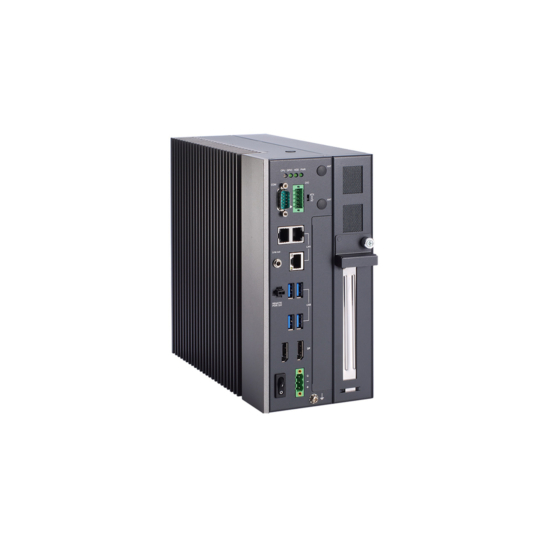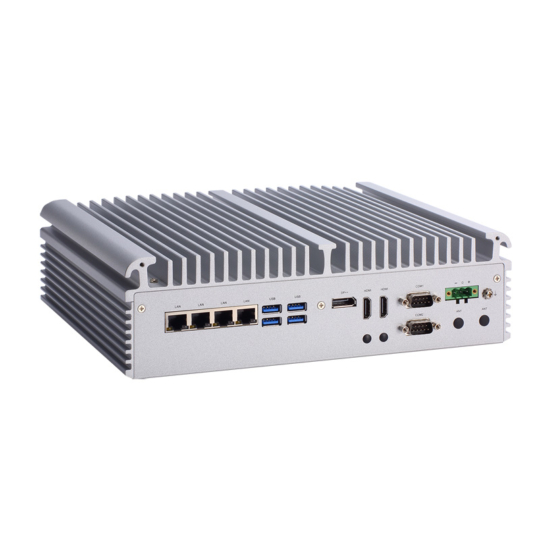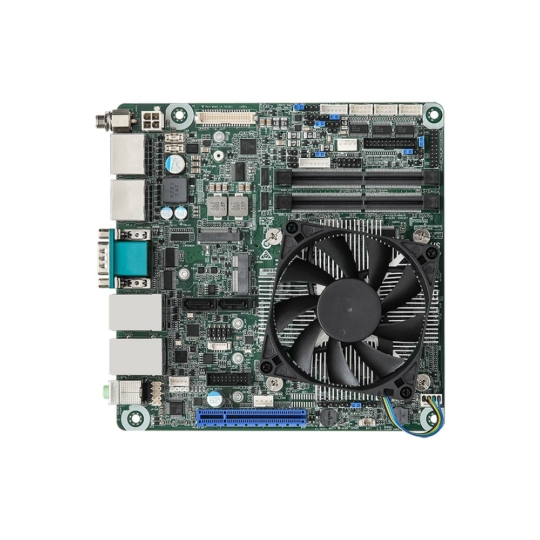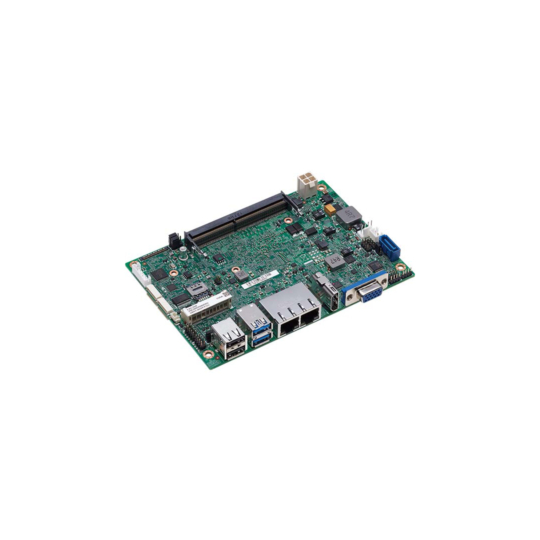Processor Base Power: Which CPU TDP For Performance, Efficiency & Reliability?
Looking to replace or install a new line of PCs in embedded or industrial applications? There is a key specification which is often overlooked that you want to watch out for, the watts. Both system reliability and efficiency depend on selecting a CPU with the right wattage and system design should factor this in when looking at the required system performance for your industrial computer.
Of course, this is application specific and there are many industries requiring different levels of rugged specification, energy efficiency or peak performance levels. In most industrial applications where harsh environmental factors are present, managing thermal transfer from a high-performance CPU requires specialist fanless PCs or single board computers with heat spreaders, which can limit the level of performance when compared to actively cooled fanned computers.
Processor Power vs Power Consumption
To start, we need to understand that power is used in two senses in industrial computing. Power is often related to the overall performance but as important is the power consumption, expressed in watts.
Understandably people think that the more watts, the more power, the better the performance. More watts is not better or worse, it simply means the amount of power it takes to run the processor at full capacity. With each new generation of CPU, an increase in performance is made when compared against benchmark processor base power figures.
The best way to compare the CPU performance is looking at processor speed, the number of cores and threads, and it’s caching capabilities. A common way to directly compare processors is with their PassMark score. You can use online tools to make direct comparisons between processors based on their real world performance.
Ongoing Running Cost of Deployment
Most industrial control systems don’t require huge amounts of processing power to carry out tasks reliably. Instead, the systems require just enough performance to operate the line of control software all-day long, every day without fail, and at the lowest cost possible.
With mass deployment of edge computers with 24/7 operation as a common pre-requisite, running costs can soon add up. With raising costs in energy prices, choosing the right CPU wattage shouldn’t be overlooked. In order to scale the cost of deployment we are going to crunch some numbers on daily and yearly running costs for a single system and then apply that to mass deployment. In this case we will look at energy efficiency of a couple Intel Core build specifications with vastly different power ratings ranging from 15W to 95W.
(A/1000) x B x 24 x 365 x C is a simple equation to calculate the total power consumption; where A is the total CPU watts, B is the cost of power per kilowatt hour, and C is the total number of systems. For this use case we will look at 100 systems being deployed with the average cost per kilowatt hour in 2022 across all US states, sitting at $0.17.
15W CPU: $6.12 per day, $2,234 per year.
35W CPU: $14.28 per day, $5,212 per year.
65W CPU: $26.52 per day, $9,679 per year.
95W CPU: $38.76 per day, $14,147 per year.
With embedded systems being deployed as long life solutions you can calculate the total cost savings by the number of years for deployment. The most common trade-off in industrial applications would be a 35W processor vs 65w processor. Based on our calculations above you’d save $4,467 in running costs per year for every 100 systems being deployed. If you multiply that by a 10 year life-cycle, you’re saving $44,670. As you can see, paying for anything more than required is a complete waste of money.
Achieving Rugged Reliability
When generating heat from the CPU some degree of cooling needs to take place so that the computer doesn’t throttle or result in system failure. When generating higher levels of heat more complex designs are required to remove heat.
In industrial environments if you have a fan, you have a point of failure. Choosing to adopt active cooling with fanned technology requires system vents that open your computer to environmental concerns such as dust and debris. There are other points of failure and drawbacks from adopting a fan onboard also, including the requirement for a larger chassis design, further power draw, and if the system is prone to shock and vibration another point of failure.
If you reduce the amount of power being drawn by the processor you also remove the need to have a fan onboard. This is step one in the design and manufacture of a fanless rugged computer.
Industrial Computing Supported By Embedded Roadmaps
Understanding TDP, PBP, MTP, T-Junction, and Thermal Throttling
When choosing a CPU for configuring your industrial embedded PC, you need to be aware of three important specifications: TDP, PBP, MTP, T-Junction, and Thermal Throttling.
Thermal Design Power (TDP): Thermal Design Power has been a term used by AMD and Intel to represent the CPU’s power consumption and heat output during operation. TDP is also known as Thermal Design Parameter, Thermal Design Point and Thermal Design Profile. This also acts as a reference point at which a CPU cooler must dissipate heat from the chip to allow it to perform as advertised. The idea behind thermal design power is to provide system designers and installers with an accurate estimate for how much energy their devices will require to transfer in terms of heat when in operation. This helps end users in the embedded market sector select the appropriate cooler for their single board computer or industrial motherboard. It also helps industrial PC manufacturers to design appropriate heatsinks for handling fanless cooling with varying levels of TDP values from the CPUs installed.
With the introduction of newer generation processors the TDP figure has become a little more vague since chips can greatly exceed their processor base power thanks to Turbo Boost and similar technologies. With the launch of the Intel Core Alder Lake series CPUs there has been an introduction of new terminology specifically for Intel platforms.
Processor Base Power (PBP): This will replace TDP, and is a measurement of the average level of heat generated during high-complexity workloads while the CPU is running at its base frequency.
Maximum Turbo Power (MTP): This figure was formally known as cTDP and represents the amount of heat generated when the CPU is running at maximum Turbo Boost frequencies over “sustained” periods, typically longer than one second.
T-Junction: The CPU also has a term called “T-Junction.” This represents the temperature measured right on its surface. Max T-junction is a value of how hot the CPU can get before thermal throttling begins, which will lower your industrial computer’s performance in order to prevent damage from occurring or increased chances of crashing due do excessive heat generation .
Thermal Throttling: Thermal throttling is a common technique for limiting processor power and protecting the embedded system from overheating. The computer’s central processing unit will decrease its speed or clock frequencies in order to cool down and bring the system back to safe operating temperatures.
The BIOS is a key component of your computer and it’s important to know how to configure it correctly. One setting that you may need to adjust is the TDP. Configuring TDP in the BIOS tells the system how much power the CPU is allowed to draw, and it’s important to get it right. If the TDP is too low, the CPU will be throttled and performance will suffer. If the TDP is too high, the CPU will overheat and the system will become damaged.
When building a computer for industrial and embedded applications it is all about the balance between performance and wattage. Higher wattage CPUs such as a 95W processor will allow your computer to run highly demanding programs but with the trade-off of requiring active cooling with an onboard fan to cool the system. In contrast, and in most use cases whereby fanless PC is preferred, you want to get a CPU ranging from 15W to 65W of TDP. Where 15W TDP would be preferred for low power embedded computers which are energy efficient, 65W CPUs are preferred for high performance fanless IPCs capable of withstanding wide operating temperatures.
Comparing Intel Core Embedded CPUs: 15W vs 35W vs 65W
Intel industrial PCs are renowned for their long-term availability, making them a popular choice for edge computing applications requiring reliable and sustainable technology solutions which would remain available for 10-15 years. Protected by Intel’s embedded roadmap, Intel CPUs for industrial applications are available in 15W mobile variants and 35W or 65W desktop variants. The embedded CPUs are easily distinguished against commercial CPUs as they finish with the letter ‘E’ at the end of their part number. Each of the Intel Core CPUs found across the i3, i5, i7 and i9 range have their own benefits and drawbacks when being deployed in industrial applications.
Intel Core 35W CPUs
Intel 35W CPUs offer several advantages in industrial applications, such as fanless operation, rugged reliability at higher operating temperatures, and lower cost of ownership with reduced operating costs. These processors are known as T versions which is referenced in the part code.
Passive Cooling With Fanless Designs: Passive cooling is one method of dissipating thermal heat transfer and offers systems an effective way to remove heat without any need for fans. As a result of fanless technology, these fanless systems not only offer longer service life with reduced maintenance, but also silent operation. Passive cooling is achieved by integrating heatsinks and heat pipes into the top of the PC chassis where fins and ribs are used to effectively dissipate the heat. Conductive materials such as aluminium and copper are most commonly used for optimum heat transfer from the CPU.
Rugged Reliability: Most edge computers require 24/7 operation without failure. This makes it paramount for the edge computer to optimally carry out tasks and reliably operate throughout its deployment. The lower Intel Core 35W CPU wattage allows the computer to run fanless, and eliminate any moving parts susceptible to failure due to presence of shock and vibration or being clogged up from dust ingress.
Reduced Overheads: The 35W Intel Core CPUs are available at a lower price point when compared to higher 65W CPUs and also reduce running overheads as they draw less power. Whilst reducing power draw they still offer sufficient clock rates or levels of processing power for demanding number crunching applications.
Extended Operating Temperatures: Extreme industrial environments require industrial PCs with extended operating temperature support. Due to less heat being generated by 35W CPU processors, a higher operating temperature of -40C to +85C can be achieved before the CPU reaches its Thermal Junction Maximum (TJMax).
Intel Core 65W CPUs
Intel 65W CPUs offer a different set advantages and drawbacks when compared to the 35W CPU in industrial applications. The main advantages of a 65w CPU is increased levels of performance whilst maintaining fanless operation. Whilst 65W IPCs still offer rugged reliability at higher operating temperatures, these temperatures are typically reduced without rugged chassis designs. Drawbacks therefore include a higher cost of ownership and increase daily operating costs.
Higher Performance Levels Remaining Fanless: As expected, the more powerful CPUs can handle an increase load of tasks. Intel 65W CPUs are commonly used for more complex industrial applications that demand more computing power. Typically, IPCs hosting 65W CPUs provide an optimal balance of powerful computing that still can maintain a robust fanless and dustproof chassis design. In order to achieve fanless operation with 65W Intel CPUs onboard, the fanless chassis architecture requires larger heatsinks and heat pipes to ensure thermal transfer of heat generation from the CPU is great enough to keep processors cool and avoid thermal throttling.
Withstand Wide Operating Temperature Deployments: Industrial grade computers configured with higher TDP Intel Core 65W CPUs can still be deployed in harsh environments requiring wide operating temperatures. Compared with the less power hungry Intel Core 35W CPU, the 65W CPU typically has a 10-20°C lower maximum operating temperature range than 35W CPUs. Sub zero operating temperatures are not affected. Most industrial use cases can accept this slightly narrower heat resistance in order to achieve more power.
Customer FAQs
Which High Performance CPUs Can Be Installed In Fanless Industrial Computers?
If you require a fanless industrial computer with higher performance levels, both Intel Core and AMD Ryzen Embedded CPUs can be installed. These systems can be deployed in harsh environments which require rugged computing.
How Important is TDP?
To keep your computer running at peak performance, you need to make sure it has the right cooling system for the CPUs TDP rating. While CPU manufacturers in the embedded sector such as Intel or AMD publish the TDP ratings for their embedded CPUs, you also have IPC and embedded PC manufacturers publish the system operating temperatures with particular CPUs installed. This typically refers to operating temperatures when the system runs under maximum theoretical load.
Is It Safe To Overclock TDP?
The best way to keep your processor cool and running at peak performance is within the appropriate CPU frequencies. The benefits of overclocking the CPU are not always worth it and more often than not, increasing the processor’s TDP will cause overheating and result in slower performance from thermal throttling. In the worst case scenario it can lead to hardware failures from overheating. Through upgrading your computer’s cooling mechanism accordingly you can dissipate the additional heat from overclocking at higher CPU frequencies. Fanless PCs utilizing heatsink technology push performance levels by installing external system fans to move air over the heatsink, this aids in system cooling without compromising the system internals with exposure to particulate matter such as dust.
Is 65W TDP Good?
Whilst 65W TDP processors generate more heat they also offer the highest level or performance for industrial computers with fanless technology.
Looking For Your Next Industrial or Embedded Computer?
Tell us about your application and a member of our team will get right back to you.




